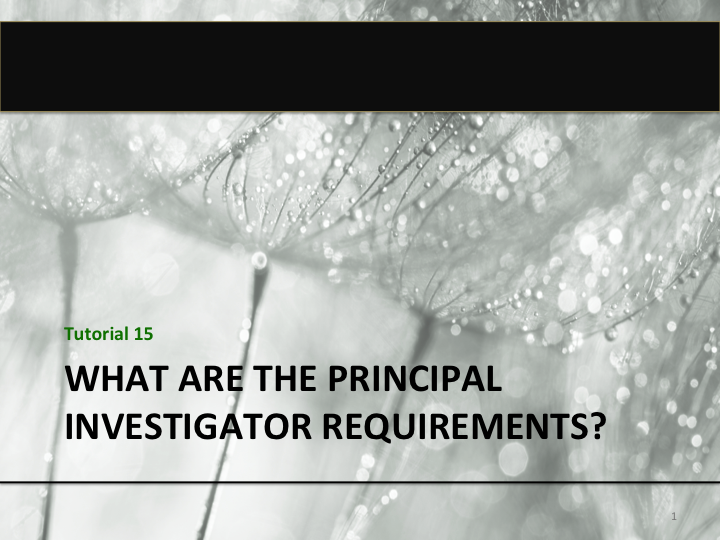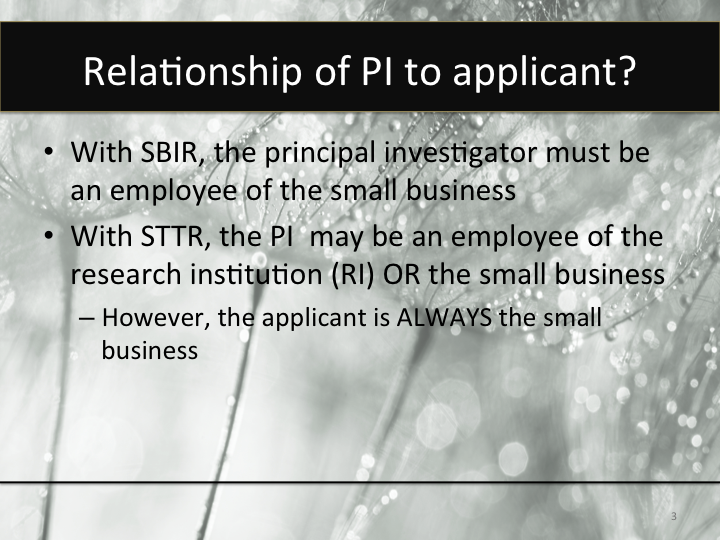Tutorial 15:
Principal Investigator (PI) and Applicant Requirements
One of the struggles for a start-up preparing to submit an SBIR or STTR proposal is to determine who should be the Principal Investigator or PI. In making this decision many things have to be considered: (1) the PIs role in the project, (2) how the credentials of the PI are likely to be perceived by the reviewers, and (3) intellectual property issues. As start-ups often need to supplement their research and development team with consultants and subcontractors we will begin this discussion with a review of the responsibilities of the applicant.
The applicant is the organization submitting the proposal and the entity with which the Department of Energy enters a grantee relationship. The applicant, in this case the small business concern (SBC) has “overall responsibility of the project, including financial management and direction and control of the performance.” The applicant also brings the resources together in order to accomplish the proposed work. The resources include employees of the applicant, as well as subcontractors, and/or consultants.
The primary role of immediate concern to the applicant is the principal investigator (PI). In the case of a Small Business Innovation Research (SBIR) application the PI must be an employee of the small business; while in the case of a Small Business Technology Transfer (STTR) application the PI may be an employee of the Research Institution (RI) to whom work has been subcontracted or the small business. Please note that when the application is for an STTR – the subcontract agreement is with the RI and not the researcher.
The Principal Investigator’s Role
So what does a PI do? The Department of Energy’s Funding Opportunity Announcement (FOA) specifies that “the Principal Investigator (PI) is the key individual designated by the applicant to direct the project. Only one PI is acceptable per project. The PI must be knowledgeable in all technical aspects of the application and be capable of leading the research effort”. So what does it mean to be knowledgeable in all technical aspects of the application? Let’s say for example that you have a Ph.D. in organic chemistry, but the proposed work requires the skills of a computer scientist – would you be a credible PI? In exploring this question, let’s further assume that you have managed many research projects during your career – but none that involve the specialized skills of a computer scientist. Your resume clearly shows however, that you know how to manage research so you believe you should be a viable PI. However, that may no be the case…
“DOE’s evaluation of the application is critically dependent upon the qualifications of the PI”. What are the technical reviewers likely to think of a PI who is capable of managing a project – but who has none of the requisite technical skills to conduct the research him or herself? Probably, your application will be viewed as risky. If you decide to take that risk anyway and list yourself as the PI – be sure to make the case why this is viable. Don’t assume the rationale is self-evident.
Another potential course of action is to modify the statement of work (SOW) so that the research requires a combination of skills – some of which are in your technical area of expertise. However, in so doing – make sure that the SOW remains aligned with the topic, is innovative, and provides good value to the Department of Energy.
How to find a PI
What alternatives do you have if you don’t have the requisite technical skills to be the PI? You must look to add someone with the skills required and make a contingent hire – i.e., find a qualified person who commits to joining your firm and serving as the PI if your company wins the award. It is important to keep in mind that “the PI’s primary employment must be with the applicant SBC at the time of award and during the conduct of the proposed research. Primary employment means that no less than 20 hours per week is spent in the employment of the applicant SBC during the conduct of the project and no more than 19 hours per week spent in the employment of another organization”. The minimum amount of time that DOE has said is credible for a PI to spend on a Phase I over a 9 month period is 3 hours per week. For example a nine-month project, lasting 39 weeks, would require a minimum commitment of 117 hours.
Another option is to submit your proposal as an STTR proposal with the PI having primary employment with the research institution. The applicant SBC must still provide technical control and oversight of the project. “If the PI is employed by the research institution, his or her primary employment (at least 20 hours per week) must be with the research institution in order to qualify under STTR and the research institution must provide at least 30% of the research effort.” Only 60% of the research effort can be subcontracted via an STTR – the rest needs to be accomplished by the small business.
Although conceptualizing your proposal as an STTR submission may solve one problem – it may lead to another issue – intellectual property (IP). If the PI is employed by a research institution and performs up to 60% of the research and makes potentially patentable discoveries – who owns the IP? It is important that you consult with the research institution to determine how this scenario would be handled – and reach an agreement that is viable before committing to proceed down the STTR route. If selected for award, DOE requires the small business to certify that you have implemented a property and commercialization rights agreement with the research institution. A copy of the certification form can be found on the DOE SBIR website: http://science.energy.gov/~/media/sbir/pdf/files/manageapp/property_and_commercialization_rights_agreement.pdf
If you have limited experience with drafting property and commercialization agreements, DOE also provides a model agreement that you can use. http://science.energy.gov/~/media/sbir/pdf/files/manageapp/doe_model_agreement_for_property_and_commercialization_rights.pdf
It should be noted that hypothetically a University (RI) professor may also be hired as a consultant to work on an SBIR proposal [not an STTR], assuming that the University allows this. However, when hiring a consultant only 30% of the SBIR proposed work may be outsourced in this fashion. This however, would not solve the PI issue. While considering how to prepare a Phase I application that is responsive to a DOE Phase topic – be sure to consider the importance of the PI. According to DOE approximately a third of a proposal’s evaluation is based on the ability of the PI, other key staff and consultants (if any) to carry out the project, as well as the adequacy of equipment and facilities to conduct the research.
Quiz: Tutorial 15: What are the Principal Investigator requirements?
1
In order to serve as a Principal Investigator (PI) on an SBIR proposal, the PI must:
Nice Work
Try Again
2
Which of the following is a true statement regarding STTR?
Nice Work
Try Again
3
When the PI is employed by a research institution, who has the overall responsibility of the STTR project, including financial management and direction and control of the performance?
Nice Work
Try Again


